With Bajpathri threatening to set off a winter of discord in Kashmir for figuring in a probable list of new firing ranges, the old scars inflicted by army’s artillery shelling continue to haunt people. Durdana Bhat treks miles in a chilly day to step into a battered hamlet nestled in lately liberated Tosa Maidan to tell the tales of its shell-shocked widows
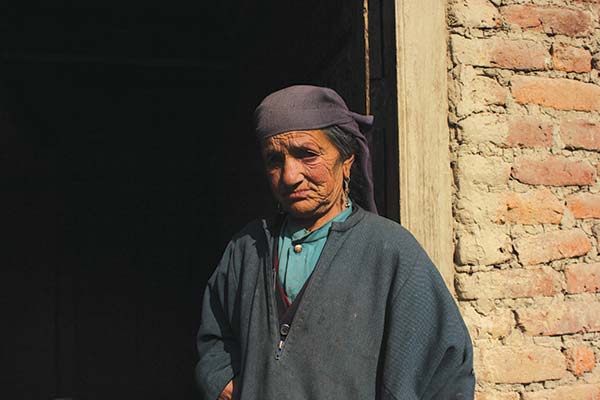
Sun was brilliantly shining over a hamlet bereft of signature countryside bustle. Those visible were shivering in the face of icy winds. Last night’s rains hadn’t subsided yet. Nearby fresh snowfall had draped mountains white. Nestled amid peaks, the hamlet was under the grip of late fall. Withered leaves had carpeted the landscape into a colourful mosaic. But behind the hamlet’s bright facade, everything was cold, presenting a woeful look—as, the landscape held in its beautiful tresses the shell-shocked stories.
The stories with multiple facets were scattered in cluster of households in the hamlet called Shunglipora. To voice these stories, grief-weighed bodies were living another day at the base of the ‘king of meadows’, Tosa Maidan. The hardened struggle to rally behind the meadow was over, so was the fear of living in the firing line. This picturesque grazing ground in Budgam leased to Indian army in 1964 for artillery drills wasn’t giving the villagers anymore sleepless nights. But a disturbed silence continued to grip it, even when 3000 kanals of land devouring 60 odd lives, maiming hundreds, was evacuated by army after 50 years of deadly shell trails.
But the footsteps of forces didn’t leave the meadow before inflicting a living trauma in the hamlets tucked in the famed meadow. Battling that trauma, scores of widows continue to make the air mournful in Tosa Maidan.
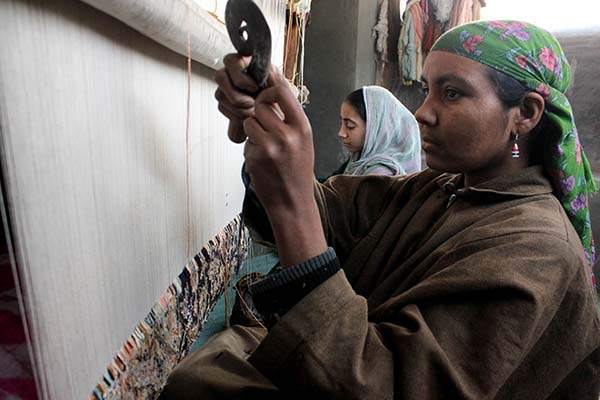
Among cluster of houses in Shunglipora, a single-storey partially completed house – accessed through a muddy well-trodden path – sheltered a widow and her daughter. Hajira, a young widow of Bashir Ahmad, was busy with her chores when the village head called her out. She took her time to emerge from dark corridor of her rundown house. The widow was dwelling a house with a disturbing aura. The moment Hajira, a frail woman in her early thirties, stepped out, she looked more than her age.
She sat down on front stairs of her house. The place was grey. Even crimson bricks, bright wooden doors and windows did nothing to undo the pervasive despair. It was as if the whole frame had been painted cold and amidst sat the widow along with her 11-year-old daughter.
Hajira was yet to step in her thirties when her 32-year-old husband was devoured by a littered shell atop Tosa Maidan. In Bashir, Hajira lost everything. “He was a carpet weaver,” spoke the young widow, gingerly renewing her grief. “He used to go up to Tosa Maidan to earn by cattle grazing.” But Bashir’s meadow march ended forever in summer 2012. “On June 9 that year,” said Hajira, “he left home never to return again.” Later her neighbours brought him home dead.
Her husband’s sudden demise was crestfallen, so was the feeling of losing the only support of her life. Within a flash, her despondency paved way to an escalating sense of deprivation. And with that, began her vicious phase of struggle. It didn’t take her much time to realise that running home besides schooling her children was beyond her strength. “It was then,” said Hajira, looking away to recollect herself, “I decided to send my 9-year-old son to an orphanage to get education.” The sudden sweeping change was testing, tolling, tearing.
The hamlet dwelled by shell-shocked families did chip in with support. They threw their weight behind the family to overcome a sense of destitution. But Hajira soon realised that she was living in the hamlet packed with artillery-decimated lives. When this realisation took roots in her, she put a brave face and became her own help.
She stepped into her husband’s shoes by weaving carpets – the skill she learned from her departed husband. Later Hajira passed the same skill to her teenage daughter. But even after putting up gruelling work hours, the mother-daughter duo ends up their day with just Rs 40. “Life is not the same again,” said Hajira while taking a good look at her daughter. “You know, my daughter often asks me: Mother, what wrong had we committed to have a brutal fate like this? Her innocent question often leaves me heartbroken. She is still too young to realise the magnitude of her loss. Hadn’t her father been consumed by a straw shell, she would have been in school – studying, dreaming, playing – and not weaving carpets…” Hajira broke down inconsolably, before blurting out, “they made my children orphan.”
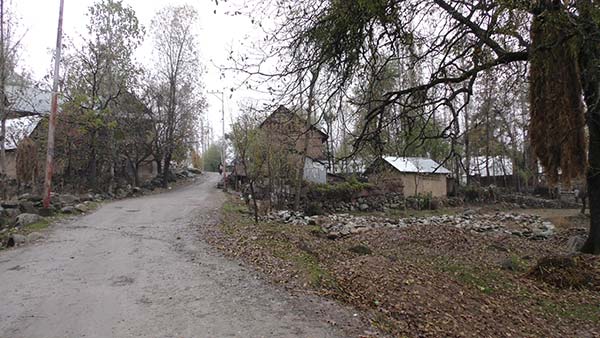
Almost every household in the hamlet has its own sob story to tell – someone’s son, someone’s child, someone’s father, someone’s husband gone with bang. Like the children’s bedtime stories with a grim face, these stories forced one to sulk away and look hard into the dark of the night due to fear.
A few metres away from Hajira’s house, a young man went to call an elderly widow, Moukta, inside her modest house. The courtyard reeked with fragrance of different spices. Momentarily, the giggles of children around clouded a sense of tragedies inflicted on their lives: their fathers, forefathers, cousins, distant cousins perished in the pasture.
Amid nonstop giggles, an elderly woman walked on the threshold of her house. She smiled confusedly after finding the village head along with some strangers in her house. Her warm, welcoming smile contrasted with her sagged, parched face. Inside her unfurnished corridor coated with mud, a smell of cooking wafted the air. Many huddled in her kitchen in kick—only to turn grim upon hearing her story of grief.
The 85-year-old Moukta lost her husband 15 years ago. Her husband, Satar Malik, a shepherd, had gone to graze his cattle to Tosa Maidan one fine day in 2000. While climbing the meadow, Malik couldn’t detect a motor shell lying hidden in bushes. He unwittingly stepped on it, triggering a blast. Malik died into pieces. Behind his death, Moukhta said, was army’s callous approach to toy with life in Tosa Maidan.
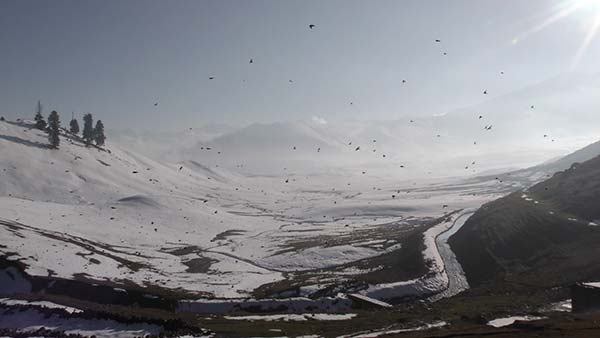
“The shell that killed my husband wasn’t there by an accident,” said the octogenarian widow, as the faces turned sullen inside her hearth-warmed kitchen. “Army while trekking Tosa Maidan on back of horses would drop shells on path without bothering to recollect them.” Those abandoned shells, she said, made many villagers a cannon-fodder.
She suddenly stopped speaking, insisting to look at her dead husband’s ID card. Without waiting for response, she dashed out of her kitchen and returned in a huff with the card. She sat down holding that card in her weathered yet unwavering hands. She began talking with fervour about her husband.
“We used to go to Tosa Maidan together,” the elder’s eyes shone with recollection, as if reliving the moment. “After his death, I continued to go up there for grazing cattle. But last year, I met an accident. And since then I am unable to move.”
Minutes later, a different crowd came out of her kitchen: sad, sullen, sighing. Moukta again flashed a confused smile before returning to her routine. She now lives with her son, who does odd jobs for living.
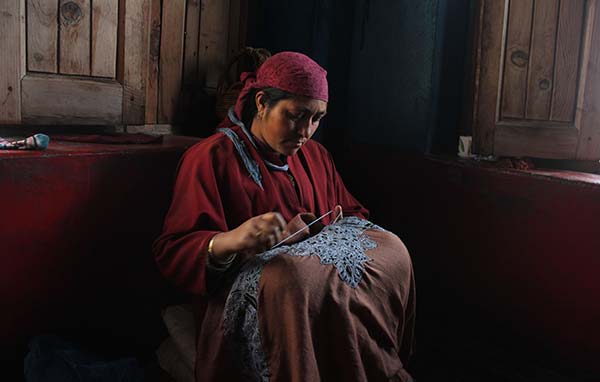
Treading softly on withered leaves through gilded autumn trees, the head of the hamlet began talking about the number of dead, deformed due to the “curse” of the littered shells. “You know,” said Mohammad Akram Sheikh, Sarpanch Shunglipora, a shell victim himself, “the government figure for the deaths due to this curse is 63. But what government won’t tell is an actual amount of human right abuses committed by army in Tosa Maidan in the name of firing drills from last 50 years. Obviously to thwart public outcry, government chose a least ‘harmful’ number.” What Akram wanted to tell was the fact—that there exist three lies: white, black and statistics.
Further walk down the hamlet led to the house of another widow, Raja Begum. She had gone to neighbouring village and was on way back. Her courtyard had a small washing basin with dishes piled up in a single tap. Beyond the courtyard, swathes of tilled farmland formed into terraces led straight to the horizon.
For a while, the gloomy lives in the beautiful hamlet began striking a contrast. From the looks, it was hard to imagine that for last half a century, the mesmerising meadow was a death trap for the villagers. They shuddered to recall how they brought down decimated fathers, sons, brothers back from Tosa Maidan. But the cost of occupation besides artillery drills was equally horrible for the living. The rattling sounds not only kept kids at bay from schools, they equally derailed the mental harmony of the villagers. “Many developed hearing impairments,” said Akram. “Besides many villagers began consulting mental specialists—as, the dread of death induced depression in them.”
But while men could move out of the hamlet to escape the assault by taking up odd jobs, women folks, especially widows, remained grounded to guard their homes. But staying back amid deafening shell explosions only took toll on them, the Sarpanch said. “That is the reason why most of them now look frail, fretful, frittered.”
In between Raja was back. After washing dishes, she sat on the small platform outside her house beneath a window. Raja was frail but energetic, sad but wilful.
Like Moukhta, she too lost her husband 15 years ago. Her husband, her only support, also became victim of the littered shell. “When an unexploded shell blew him (her husband) into pieces,” said Raja, “I was shattered into pieces, too.”
In 2000, Wali Mohammad Sheikh, Raja’s husband was climbing up to Drang village towards Woodermaidan area. A shell was washed down to Drang from the firing range. Sheikh stepped on it and exploded into pieces. “When the news reached Shunglipora,” she said, “some of the villagers went to bring his corpse but couldn’t locate his whole body.”
After his death, Raja had to become a “man” for the sake of her kids. “My late husband taught me the needle works,” she said. “I began doing that to sustain my family needs.”
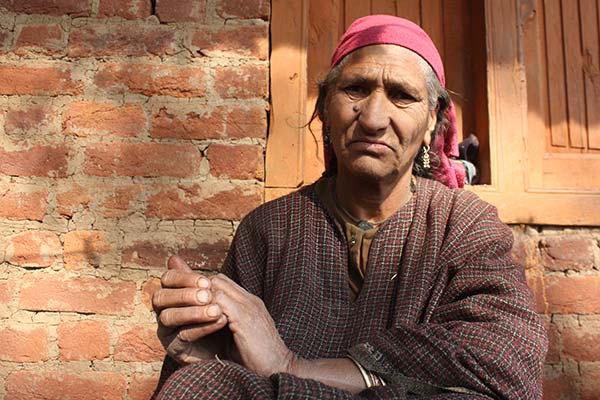
To sustain themselves and their families, these widows work as farmers, carpet weavers or craftswomen. Almost all widows were trained in different skills by their departed husbands—as if knowing their fate in advance in the fatal pasture they roamed with their cattle before being bumped off.
At a short walk ahead, another widow, Lalie was busy sewing inside her house. In 2012, she also faced the grim loss when her husband Abdul Satar Sheikh (60) was killed in an “unannounced” shelling session at Tosa Maidan.
Lalie wore a calm face, prudently concealing her sense of loss. “In the evening,” Lelie halted the sewing machine to recall the fateful day, “my husband came out of the hut to assemble the stock.” Army’s firing practice was going on but, Lelie said, they didn’t inform the couple about the shelling beforehand—the claim touted by army mostly in their defence.
He stepped onto a stray shell, got severely injured. Sheikh was rushed to a Srinagar hospital for the treatment where he succumbed to his injuries after three days. “His death left us abandoned,” Lelie said. “I have five daughters, three sons. It is very difficult to live without him.”
Not far from Lelie, another wretched widow of Shunglipora was busy earning a day for her children. Dwelling inside a single-storey brick house near Government Middle School, the widow of Satar Malik, Raja was wearing no different appearance than other widows: morose and mournful.
Raja lost Malik ten years ago to a stray shell. “He died in Tosa Maidan,” she only could say this before slipping into silence. The widow in her forties sustains her five children by doing needle work on shawls. After her husband’s death, a labourer, Raja finishes a single shawl in a month fetching her around Rs 2500.
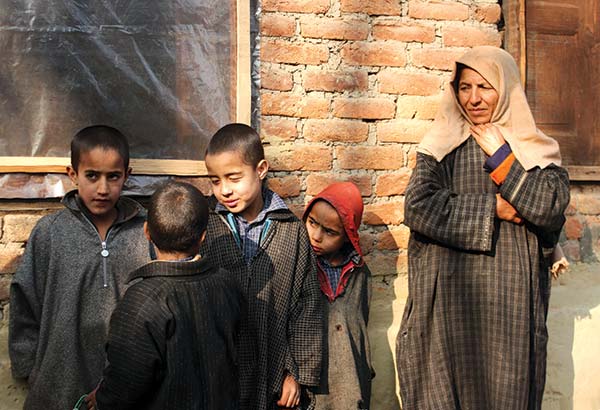
It was already sundown when Shunglipora began appearing like a dungeon – detaining all signs of life. Perhaps the 50 years of ruthless routine will take some time to break away. What possibly will remain is the void created by shells in the lives of Hajira, Moukhta, Lelie, Raja and many other wretched widows of the Tosa Maidan.
















Tosa Maidan is known for these scary incidents. I am surprised why isn’t govt. doing anything about it.Can anyone let me know if these shells still exist in Tosa Maidan and thus pose further danger.There is a technology, Ground Penetrating Radar(GPR), which can map underground features and is used extensively to locate mines.I am a masters student at Indian Institute of Technology(IIT),Gandhinagar and I am working on GPR. Somehow if its possible to find a solution to this problem, I would be happy to help if directed to concerned authorities.